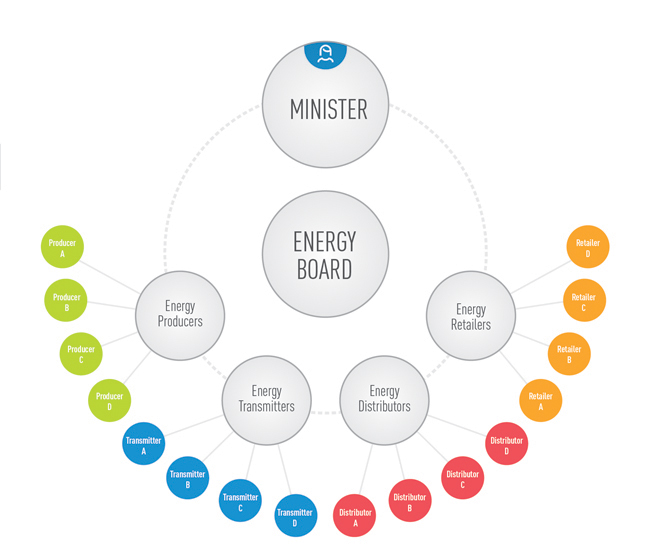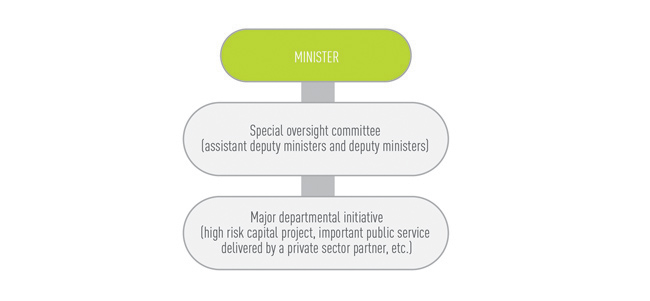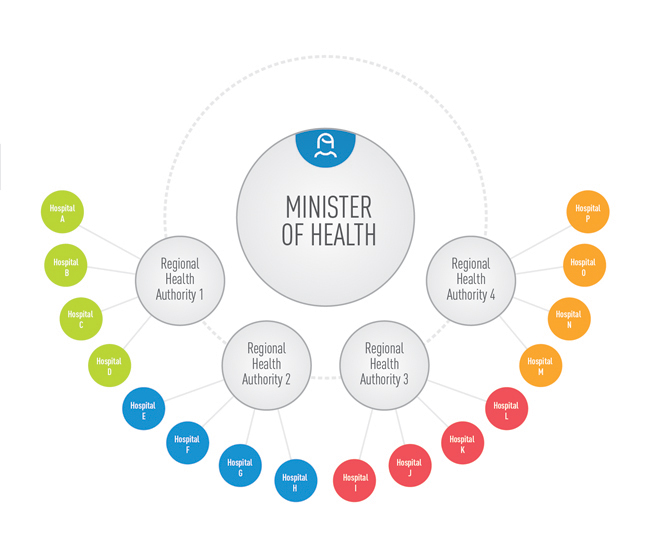The Hierarchy of Oversight Responsibilities
Oversight responsibilities in public sector organizations do not all rest with a single body or a single hierarchical level. Rather, they can be distributed at different levels.
This Practice Guide focuses on high-level oversight responsibilities in two specific situations (public agencies, boards or authorities and major initiatives in ministries and departments) and does not include in-depth consideration of day-to-day management and controls (that is, at the operational and tactical levels). A brief overview of other situations is presented below to illustrate the diversity of oversight roles in public sector organizations.
For example, within a Crown corporation or agency, a board or an authority, the various oversight responsibilities are distributed among different managers, functions, and bodies:
- Operational line managers—These managers oversee business operations in which day-to-day transactions are entered and processed.
- Tactical oversight functions—These functions are centralized competence centres, like finance, risk management, compliance, and human resources. These tactical oversight functions monitor, facilitate, and coordinate the activities of business lines, to ensure they are operating effectively, within budget, and in compliance with corporate policies.
- Executive management—These managers are responsible for running and overseeing the business of the organization and developing corporate strategies for approval by the board of directors. They are also expected to provide representations to the board of directors to the effect that the organization’s objectives are being achieved.
- Board of directors—The board is responsible for governing the organization and overseeing its activities and the performance of executive management in implementing corporate strategies.
In addition, Crown corporations and other similar organizations are subject to oversight by their responsible Minister and may also be overseen by one of several independent regulatory agencies, depending on the economic sector and jurisdiction in which they operate.
For example, Figure 4 illustrates a situation where a provincial Minister of Health has oversight responsibility for a number of regional health authorities, which themselves have oversight responsibilities for the activities of several hospitals in their respective region. In this case, the chair of the board of each of these regional health authorities is accountable to the Minister. In Figure 5, a regulatory agency, in this case an energy board, has oversight responsibilities for a number of energy producers and their various power plants. The energy board itself is overseen by a Minister.
Figure 4
Example of Ministerial Oversight for Arm's-Length Organizations
Figure 5
Example of a Regulatory Body and its Oversight

Similarly, central agencies have their own oversight responsibilities, focusing on the implementation of key policies by a jurisdiction’s departments and agencies. Figure 6 presents an example where a central agency has oversight responsibilities for the implementation of policies on the management of major Crown projects.
Figure 6
A Central Agency and its Oversight of the Implementation of a Policy on Major Crown Projects

Finally, internal oversight mechanisms can be established for major initiatives within departments or agencies.Figure 7 illustrates a case where a special committee composed of assistant deputy ministers and a deputy minister has been set up to oversee a major initiative. This committee is independent from the day-to-day management of the initiative and is accountable to the department’s Minister.
Figure 7
A Special Oversight Committee Established within a Department to Oversee a Major Initiative

In major initiatives (critical public sector projects, programs, and services), oversight responsibilities covered in the Practice Guide are those exercised by the minister and by any special oversight body put in place to oversee the project, program, or service.
In public agencies, boards and authorities, oversight responsibilities covered in the Practice Guide are those exercised by the board of directors or equivalent oversight body, as well as those of the minister charged with overseeing the board of directors or oversight body.
These two distinct situations are covered in more detail in the Concepts and Context part of this Practice Guide and are also the main focus of the Audit Methodology part. Although the Practice Guide does not provide guidance specifically tailored for auditing the oversight of regulatory agencies that are not governed by a board of directors or a similar oversight body, auditors interested in these topics can use and modify the examples (indicators, questions, objectives, criteria) provided in the Practice Guide to meet their own needs. Some of the guidance may also be useful as a starting point to audit common oversight mechanisms in ministries and departments.



